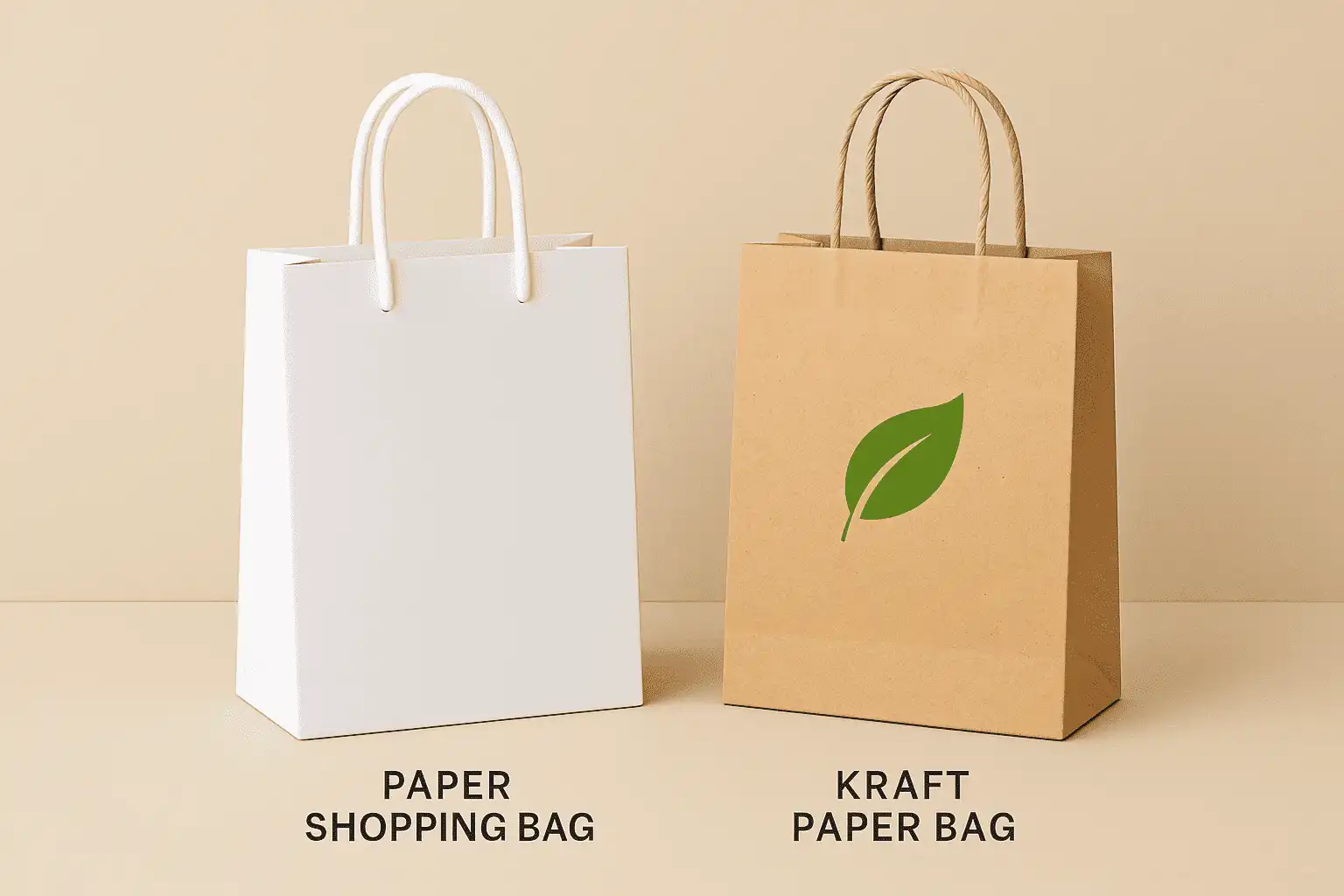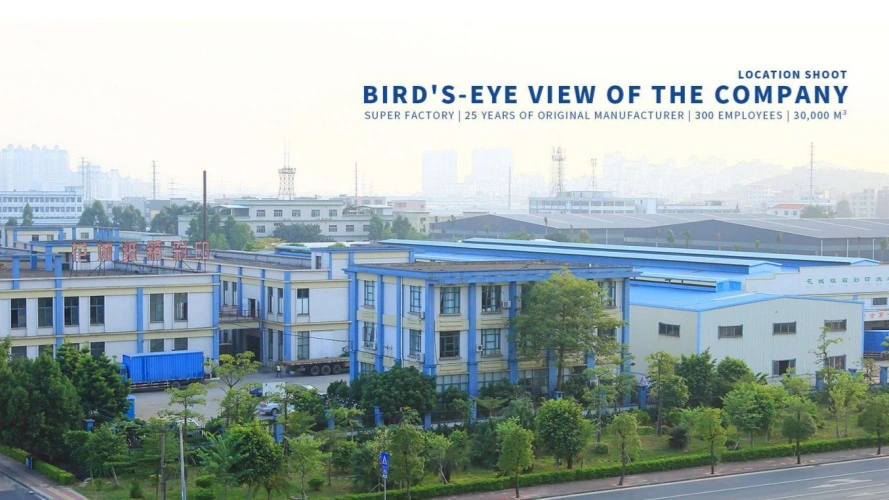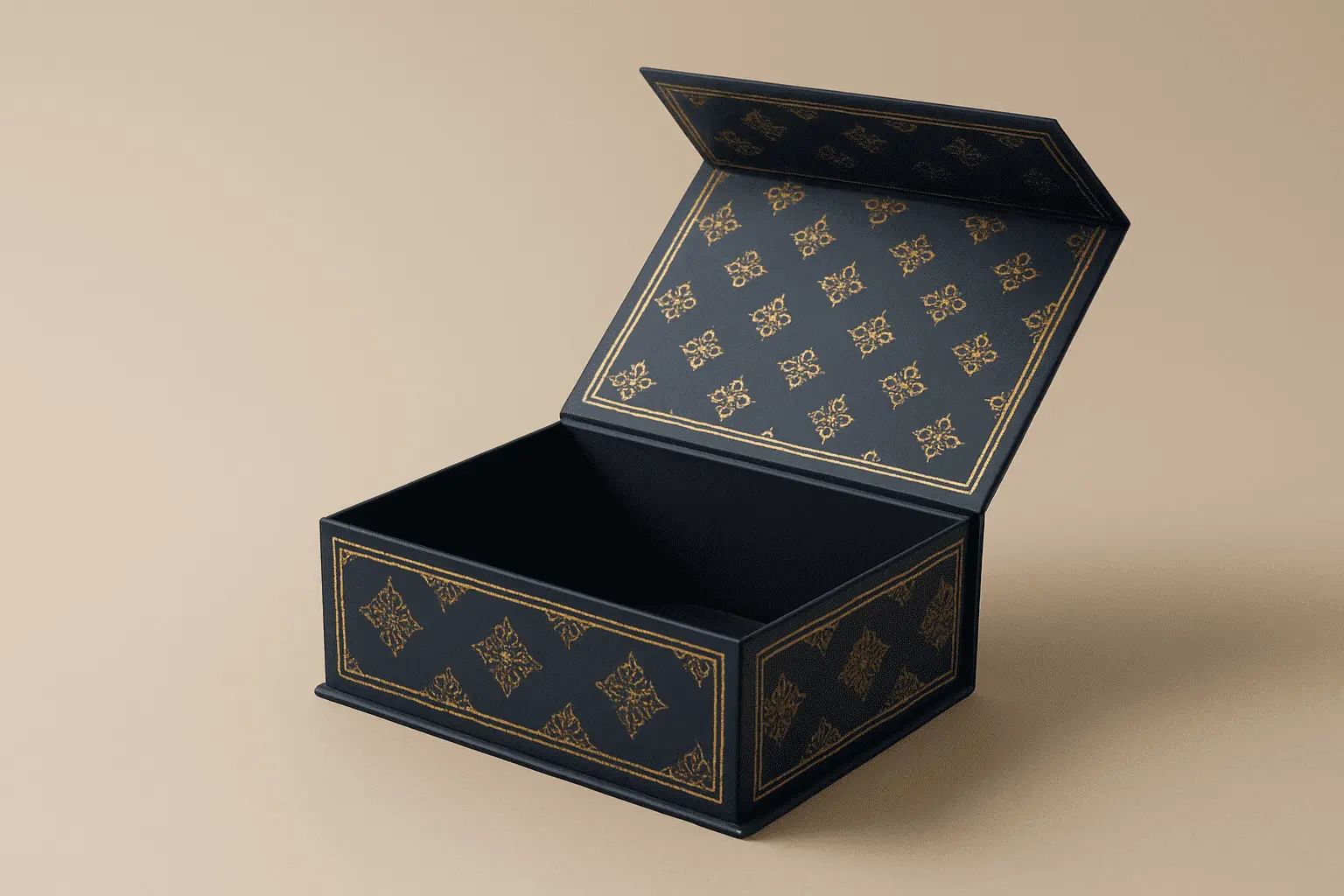Paper Shopping Bag vs Kraft Paper Bag: Which Fits Your Brand Best
When standing in the checkout line, you've probably noticed how some brands hand you a sleek, glossy paper shopping bag while others opt for that natural, earthy kraft paper. This isn't just a random choice—it's a strategic brand decision that speaks volumes about identity, values, and customer perception. Choosing between a paper shopping bag and a kraft paper bag can make or break your brand's first physical impression, affecting everything from perceived quality to environmental credibility.

Understanding the Core Differences Between Paper Shopping Bags and Kraft Paper Bags
The fundamental distinction between standard paper shopping bags and kraft paper bags lies in their manufacturing process and visual presentation. Paper shopping bags are typically produced using bleached pulp materials such as SBS C1S or SBS C2S, which create a pristine white surface perfect for vibrant printing and premium finishes. These bags undergo coating treatments that deliver smooth, high-gloss surfaces capable of reproducing intricate designs with exceptional clarity. In contrast, kraft paper bags retain the natural brown coloration of unbleached wood pulp, preserving the authentic fiber texture that gives them their characteristic rustic appearance. This unbleached production method not only maintains the material's inherent strength but also reduces chemical processing, making kraft bags an environmentally conscious choice that resonates with eco-aware consumers.
The production capabilities at modern facilities demonstrate how both paper shopping bag types can be customized to exact specifications. Using advanced printing technology including offset, digital, and flexo presses, manufacturers transfer designs onto either bleached white surfaces or natural kraft backgrounds. The choice of substrate fundamentally influences the final aesthetic—white paper shopping bags provide a blank canvas for bold CMYK printing or precise Pantone color matching, while kraft paper bags offer that organic, handcrafted appeal that aligns with sustainable brand positioning.
Material Composition and Environmental Impact
When evaluating paper shopping bags versus kraft alternatives, material composition plays a crucial role in both performance and sustainability. Premium paper shopping bags often utilize SBS C2S paperboard, which features coating on both sides for exceptional print quality and structural integrity. This virgin bleached pulp material delivers superior brightness and whiteness, enhancing image contrast and creating that luxury feel associated with high-end retail experiences. The material is fully recyclable and available with FSC certification, meeting modern environmental packaging standards while maintaining food-safe and hygienic properties suitable for direct contact applications.
Kraft paper bags, manufactured from unbleached wood pulp, present a different sustainability profile. These bags boast high tensile strength, tear resistance, and abrasion resistance while maintaining a lower environmental footprint due to reduced chemical processing. The slightly coarse surface with its authentic rustic hand-feel communicates environmental responsibility without words. Both paper shopping bag options can incorporate FSC-certified materials, ensuring responsible forest management, but kraft paper's unbleached nature often positions it as the more eco-conscious choice in consumer perception, even when both materials offer comparable recyclability and biodegradability.
Visual Appeal and Brand Positioning Through Paper Shopping Bag Selection
Premium Aesthetics with Coated Paper Shopping Bags
For brands targeting luxury positioning, coated paper shopping bags deliver unmatched visual sophistication. The smooth, clay-coated surface of materials like SBS C1S provides an ideal foundation for specialty finishing techniques including cold or hot foil stamping, UV coating, frosted touch effects, and embossing. These surface processes dramatically enhance the overall packaging visual effect, transforming a simple paper shopping bag into a memorable brand touchpoint. The bright white appearance produced from fully bleached fibers creates a clean, uniform background that makes colors pop with vibrancy and fine details emerge with clarity.
This premium substrate excels when brands require complex graphics, photographic imagery, or intricate patterns. The coated surface accepts ink uniformly, preventing absorption inconsistencies that could compromise print quality. When customers receive a paper shopping bag with flawless color reproduction and tactile finishing elements, they unconsciously associate these quality cues with the products inside. Cosmetics brands, high-end fashion retailers, and luxury gift shops frequently choose coated paper shopping bags precisely because the packaging itself becomes part of the premium experience, justifying higher product prices through consistent quality signals.
Authentic Brand Storytelling with Kraft Paper Shopping Bags
Kraft paper bags tell a fundamentally different brand story—one rooted in authenticity, sustainability, and honest craftsmanship. The natural brown hue and visible fiber texture immediately communicate environmental values without requiring explicit messaging. For organic food brands, artisanal makers, and companies emphasizing sustainable practices, kraft paper shopping bags align packaging with core brand promises. The material's earthy appearance creates an instant visual shorthand for "natural" and "eco-friendly" that resonates powerfully with environmentally conscious consumers.
Despite their humble appearance, kraft paper shopping bags offer surprising versatility in customization. The natural surface accepts screen printing beautifully, with darker inks creating strong contrast against the brown background. Many brands leverage the inherent color of kraft paper as part of their design aesthetic, using minimal printing to reduce environmental impact while maximizing visual authenticity. The slight coarse texture adds tactile interest that smooth, coated paper shopping bags cannot replicate, engaging customers through multiple sensory channels and creating a memorable unboxing experience that reinforces brand values.
Functional Considerations and Handle Options for Paper Shopping Bags
The structural performance of paper shopping bags extends beyond aesthetics to practical functionality. Handle selection significantly impacts both user experience and brand perception. Twisted paper handles, crafted by tightly twisting several strands of kraft or recycled paper into rope-like forms, offer high load capacity while remaining fully recyclable alongside the bag. These handles distribute weight evenly, preventing tearing even when customers fill paper shopping bags with substantial purchases. The textured spiral pattern adds visual depth while providing secure grip, and the handles can be dyed or printed to match any brand color palette.
For premium positioning, cotton rope handles elevate paper shopping bags to luxury status. Made by tightly braiding 100% cotton yarn into sturdy cords, these handles deliver superior comfort—the soft, rounded cord won't dig into hands even when carrying heavy loads. The natural textile appearance enhances perceived quality, signaling attention to detail that customers associate with premium brands. Cotton handles readily accept vibrant dyes for precise brand color matching while maintaining their eco-friendly credentials as biodegradable natural fibers. Satin ribbon handles take luxury even further, with silky surfaces that reflect light and create elegant draping effects perfect for gift presentation.
Die-Cut Handles and Minimalist Design
Die-cut handles represent the intersection of functionality and contemporary aesthetics in paper shopping bag design. These handles are formed by punching or cutting shapes directly into the bag's top panel, eliminating separate handle materials entirely. The integrated design creates a sleek, seamless look while maintaining full structural integrity. This approach proves particularly cost-effective, requiring no additional raw materials or assembly steps while achieving a streamlined aesthetic that emphasizes bag graphics and branding.
The environmental advantages of die-cut handles align well with sustainability goals—the entire paper shopping bag remains a single-material item, fully recyclable without separation concerns. Properly sized and reinforced cuts distribute weight evenly, providing surprising durability despite the minimalist construction. For brands emphasizing modern, clean design language, die-cut handles offer sophisticated simplicity that appeals to contemporary consumers who appreciate functional elegance over decorative excess.
Production Capabilities and Customization Options
Manufacturing paper shopping bags involves a sophisticated production process that transforms raw materials into finished packaging through multiple stages. The process begins with printing, where designs are transferred onto paper or board using offset, digital, or flexo presses depending on run size and complexity requirements. Surface finishing follows, enhancing and protecting the print by adding coatings or varnishes such as UV, matte, or gloss formulations. Lamination or mounting operations bond printed sheets to sturdier substrates or apply clear films for extra durability, particularly important for paper shopping bags destined for heavy-duty retail use.
Die-cutting uses custom metal dies to cut precise shapes, create viewing windows, or trim edges with exact specifications. This stage determines the bag's final form and handle configuration. Gluing and assembly operations fold and secure die-cut pieces together, transforming flat sheets into three-dimensional paper shopping bags ready for use. Finally, packing and shipping operations stack, bundle, or carton completed products before palletizing and dispatching them to clients. This comprehensive production process ensures every paper shopping bag meets exact specifications while maintaining consistent quality across large order quantities.
Material Selection and Advanced Printing Techniques
Beyond standard white or kraft options, paper shopping bags can be produced using specialized materials for specific brand requirements. Metallic paper, produced by laminating metal foil or applying metallic-effect coatings onto substrates, yields vivid reflective finishes available in silver, gold, copper, and rainbow variations. These materials instantly elevate perceived luxury and deliver exceptional shelf appeal, making paper shopping bags stand out at retail displays and trade shows. The mirror-like or pearlescent sheen proves compatible with spot UV, hot-foil stamping, and embossing techniques for layered visual effects.
CCNB (Clay Coated News Back) offers an economical alternative for brands requiring good print quality at competitive pricing. This recycled-fiber paperboard features a white clay-coated front for high-quality printing and a grey uncoated back that provides structural strength. Despite its recycled content, CCNB maintains decent stiffness suitable for retail paper shopping bags while supporting sustainability initiatives through high recycled material content. The cost-effectiveness makes CCNB ideal for high-volume applications where environmental responsibility and budget consciousness intersect.
Strategic Selection Criteria for Your Brand
Choosing between paper shopping bags requires careful consideration of multiple factors beyond simple aesthetic preference. Brand positioning forms the foundation—luxury brands typically demand the pristine surfaces and specialty finishing capabilities of premium coated materials, while sustainable or artisanal brands find authentic alignment with kraft paper's natural appearance. Target audience expectations play an equally important role; younger, environmentally conscious consumers often respond more positively to kraft paper shopping bags, perceiving them as evidence of genuine environmental commitment rather than greenwashing.
Budget considerations extend beyond unit cost to include design complexity and finishing requirements. Kraft paper shopping bags generally cost less due to simpler production processes and reduced finishing needs, while premium coated paper shopping bags command higher prices but justify this through superior print quality and customization options. Order volume affects pricing significantly, with larger runs reducing per-unit costs across all material types. The ordering process typically begins with demand consultation where customers submit contact emails to explore options, followed by solution design where business managers conduct detailed content discussions, professional implementation involving sample production and detail confirmation, and finally successful order placement after customer approval and deposit payment.
Conclusion
Selecting between paper shopping bags and kraft paper bags ultimately depends on aligning packaging choices with brand identity, target audience values, and functional requirements while balancing aesthetic aspirations with budget realities.
Cooperate with GUANGZHOU FETCHING COLOR PRINTING & PACKAGING LTD.
As a China paper shopping bag manufacturer with over 20 years of experience, GUANGZHOU FETCHING COLOR PRINTING & PACKAGING LTD. operates a 35,000㎡ facility employing 300+ skilled professionals serving over 1,000 loyal customers worldwide. Our China paper shopping bag factory features industry-leading equipment including German Heidelberg printing machines, 15 automatic die-cut machines, and comprehensive finishing capabilities. As a trusted China paper shopping bag supplier, we maintain ISO14001, ISO9001, FSC, G7 Color Management, Smeta, and Disney certifications. Whether you need High Quality paper shopping bag solutions, competitive paper shopping bag price options, or China paper shopping bag wholesale services, our expert R&D team delivers customized packaging that elevates your brand. Contact our China paper shopping bag factory today at public@fetchingprinting.com to transform your packaging vision into reality—because your success is our success.
References
1. "Sustainable Packaging: The Role of Kraft Paper in Modern Retail" - Journal of Packaging Technology and Research, Volume 7, Issue 2, 2024, authored by Dr. Sarah Mitchell and Prof. James Chen
2. "Consumer Perception of Packaging Materials: A Comparative Study of Bleached versus Unbleached Paper Products" - International Journal of Marketing Studies, 2024, authored by Dr. Emily Rodriguez and Dr. Thomas Wang
3. "Environmental Impact Assessment of Paper-Based Shopping Bags: Production Methods and Lifecycle Analysis" - Environmental Science and Sustainability Journal, Volume 12, 2024, authored by Prof. Michael Green and Dr. Linda Patterson
4. "Brand Identity and Packaging Design: How Material Selection Influences Customer Purchase Decisions" - Brand Management Quarterly, First Quarter 2025, authored by Dr. Robert Williams and Prof. Jennifer Lee

Based on your location and order quantity, you will have the opportunity to receive a limited time free shipping promotion!

Corporate Purpose
